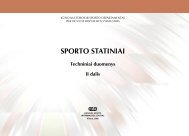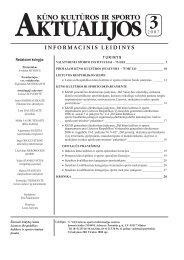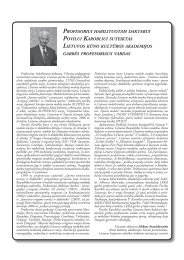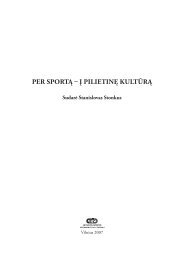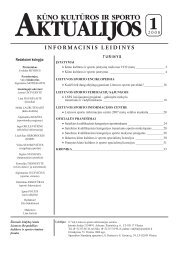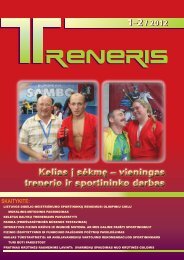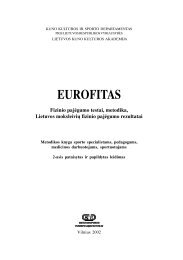Nr. 1 - Lietuvos sporto informacijos centras
Nr. 1 - Lietuvos sporto informacijos centras
Nr. 1 - Lietuvos sporto informacijos centras
Create successful ePaper yourself
Turn your PDF publications into a flip-book with our unique Google optimized e-Paper software.
2010 <strong>Nr</strong>. 1(59)<br />
41<br />
lipid and glucose metabolism in women undergoing moderate<br />
weight loss by diet plus exercise. Nutrition, Metabolism and<br />
Cardiovascular Diseases, 2:159–164.<br />
5. Helge, J. W., Richter, E. A., Kiens, B. (1996). Interaction of<br />
trainng and diet on metabolism and endurance during exercise<br />
in man. Journal of Physiology, 492, 293–306.<br />
6. Howley E. T., Don Franks, B. (1997). Health Fitness<br />
Instructor’s Handbook. Champaign, IL: Human Kinetics.<br />
7. Klem, M. L., Wing, R. R., Mc.Guire, M. T., Seagle,<br />
H. M., Hill, J. O. (1997). A descriptive study of individuals<br />
successful at long-term maintenance of substantial weight<br />
loss. Am J Clin Nutr, 66, 239–246.<br />
8. Kraemer, W. J., Ratamess, M. A. (2004). Fundamentals<br />
of resistance training: progression and exercise prescription.<br />
Med Sci Sports Exerc, 36 (4), 674–688. Review.<br />
9. Kokkinos, P. F., Papademetriou, V. (2000). Exercise and<br />
hypertension. Conor Artery Dis., 11, 99–102.<br />
10. McArdle, W. D., Katch, F. I., Katch, V. L. (2007). Exercise<br />
Physiology: Energy, Nutrition and Human Performance<br />
(Sixt edition). Philadelphia, New York, Tokyo: Lippinccot<br />
Williams and Wilkins.<br />
11. Skurvydas, A., Zuozienė, I. ir kt. (2006). Fizinis aktyvumas<br />
ir sveikata: mokomoji knyga (pp. 7–12). Kaunas: LKKA.<br />
12. Schoeller, D. A., Fjeld, C. R. (1991). Human energy<br />
metabolism: what have we learned from the doubly labeled<br />
water method? Annu Rev Nutr, 11, 355–373.<br />
13. Sharkey, B. J., Gaskill, S. E. (2006). Fitness and Health.<br />
Champaign, IL: Human Kinetics.<br />
14. Stewart, C. E., Rittwegr, J. (2006). Adaptive processes in<br />
skeletal muscle: molecular regulators and genetic influences.<br />
J Musculoskelet Neuronal Interact, 6(1), 73–86. Review.<br />
15. Vasiliauskas, D., Lazarevičius, A. (1999). Antrinė<br />
išėminės ligos profilaktika. Kaunas.<br />
16. Wackerhage, H., Atherton, P. J. (2006). Adaptation to<br />
resistance training. In: N. Spurway, H. Wackerhage (Eds.),<br />
Genetics and Molecular Biology of Muscle Adaptation<br />
(Advances in Sport and Exercise Science)(pp. 197–225).<br />
Edinburgh: Churchill Livingstone.<br />
17. Wilmore, J. H., Costill, D. L. (2004). Physiology of<br />
Exercise and Sport. Champaign, IL: Human Kinetics.<br />
18. WHO (2002). World Health Report. Prieiga per internetą:<br />
http://www.who.int/whr/2002/en/<br />
The influence of purposeful physical loads on physical fitness<br />
of the individuals exercising in fitness centres<br />
The increase of general physical activity and interest<br />
in personal health in population demands attractive<br />
and effective training programs, new methods, new<br />
knowledge, ergonomic therapy equipment and safe<br />
environment from sport specialists. It’s also required that<br />
training programs should not be just safe and effective<br />
but also the result should be evident and measurable.<br />
The aim of the research was to explore the influence of<br />
different types of physical load on physical fitness in groups<br />
of males and females. The healthy 25-50 years old women<br />
(n=16) and men (n=20) who attended sport club „Linija“<br />
took part in the research. We divided the participants into<br />
two groups according to the training character, in order to<br />
evaluate the effect of applied programs. 8 women and 10<br />
men participated in A group and had dominantly aerobic<br />
training sessions. Other 8 women and 10 men participated<br />
in B group and had dominantly strength endurance training<br />
sessions. The program lasted for two months and the<br />
training sessions were held two times per weeks for 90 min.<br />
The participants were assessed before training sessions.<br />
Retest was made after the period of entire program.<br />
Such parameters of body composition were assessed:<br />
the body weight, body mass index, body fat percentage,<br />
the proportion of waist and pelvis. Physical fitness was<br />
determined by maximum oxygen intake, aerobic capacity<br />
______________________________________________________________________________________________________________________________________________________<br />
Ilona Judita Zuozienė<br />
<strong>Lietuvos</strong> kūno kultūros akademija<br />
Sporto g. 6, LT–3000 Kaunas<br />
Tel. +370 37 302 666<br />
El. paštas: i.zuoziene@lkka.lt<br />
Assoc. Prof. Dr. Ilona Judita Zuozienė, Assoc. Prof. Dr. Diana Rėklaitienė<br />
Lithuanian Academy of Physical Education<br />
Summary<br />
and strength of different groups of muscles.<br />
After 2 months training sessions the weight and body<br />
mass index haven’t changed significantly. Body mass<br />
index has slightly increased (0,3 kg/ m 2 ) for men in A<br />
group and decreased (0,2 kg/m 2 ) in B group. Body mass<br />
index hasn’t changed for women. Body fat percentage<br />
has decreased after 2 months training program<br />
significantly (p



